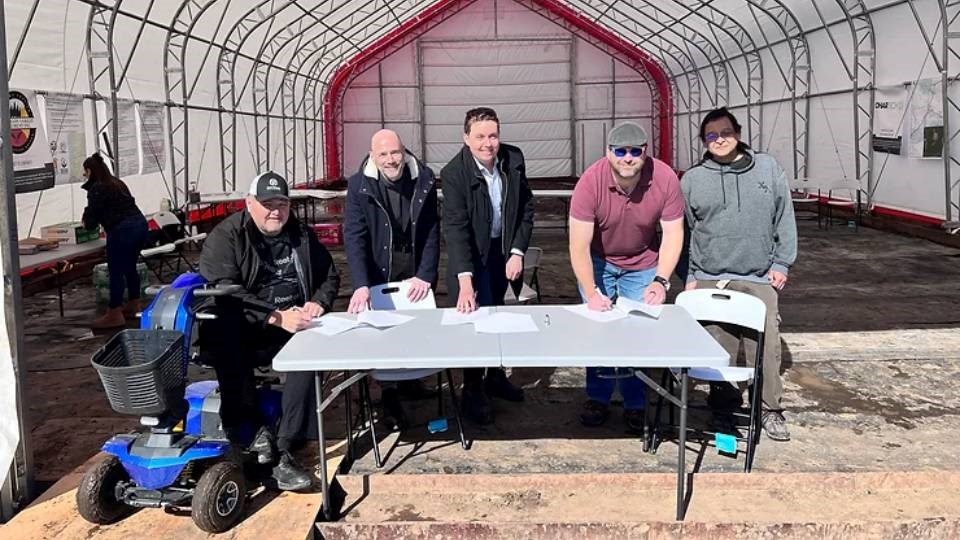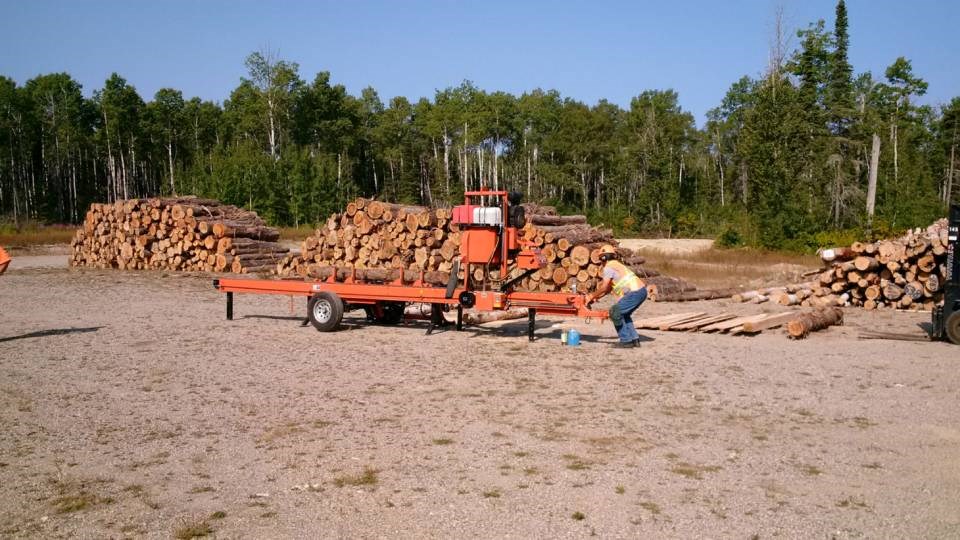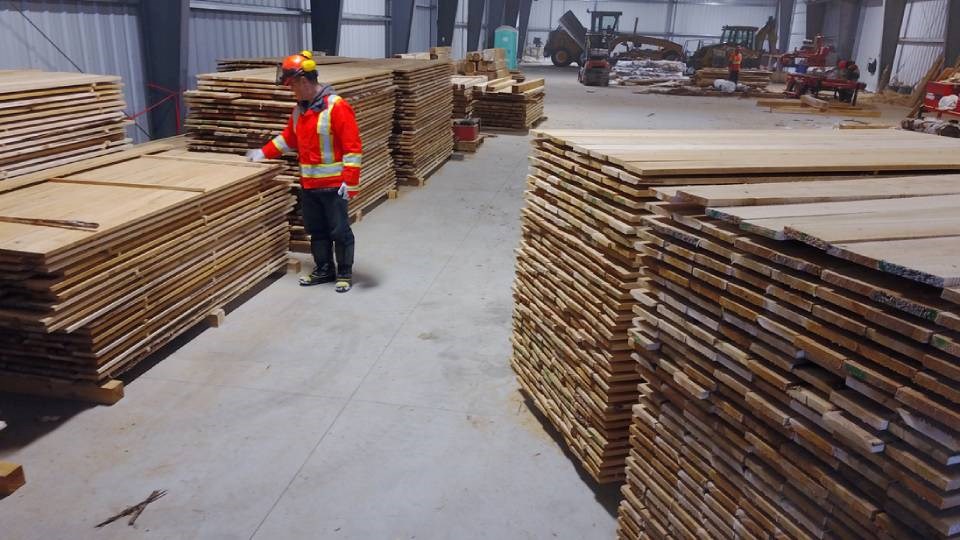Bingwi Neyaashi Anishinaabek’s (BNA) years-long journey toward biomass adoption has been marked by a series of starts and stops.
But this fall, the northwestern Ontario Ojibwe community expects to be closer than ever to helping its residents establish themselves as leaders in the area of alternative energy.
Discussions around the use of biomass in the community, whose traditional territory is situated along the southeast shores of Lake Nipigon, began well over a decade ago. But it wasn’t until 2017, when the community launched Papasay Value Added Wood Products, operating as Papasay Sawmill, that their work got underway in earnest.
At that time, the leadership wanted to establish an anchor project that would kickstart economic development and help displaced members return home, noted Jordan Hatton, the economic development officer for Bingwi Neyaashi, also known as Sand Point First Nation.
Papasay Sawmill started with three employees, producing rough-sawn, air-dried lumber, but the operation was rudimentary at the outset.
“We’re building from scratch at Sand Point, so that includes core infrastructure,” Hatton said. “So there was no heat to the building. So when they were first working in 2017-2018, it was working in -40. It was freezing.”
Using funds from Natural Resources Canada (NRCan), the community outfitted the sawmill with a small, 150-kilovolt Froling boiler that’s fed by wood scraps leftover from the milling process. Its impact was felt immediately.
It reduced the mill’s greenhouse gas emissions, while using up its own wood residue and greatly improved working conditions for staff.
“Actually, now the guys are working in the wintertime in their T-shirts, which is pretty cool,” Hatton said.

In 2022, Papasay received $1.7 million in federal funding to expand the building and purchase new equipment with the goal of introducing a value-added line.
The sawmill was Bingwi Neyaashi’s first real step into biomass, Hatton noted, but the community wanted to do more to reduce its reliance on other power sources.
Next up in the plans was a district heating biomass program that would expand to the entire community. Under that plan, existing and newly built homes and community buildings would be retrofitted with biomass boilers.
Part of the early challenge in getting people on board was overcoming negative perceptions of the forest industry as being destructive to the environment, Hatton noted. Imagery of scarred land left behind by clearcutting operations scared people off the idea for many years.
But forestry has been a longstanding industry in the North, including at Bingwi Neyaashi, where the community operated a small sawmill through the 1920s and 1930s, Hatton said.
It was destroyed, along with the community, when the governments of the day seized land to construct hydroelectric projects, and later a provincial park, that dispersed their members across the country.
“There’s a long history of us utilizing forestry responsibly and sustainability in our operations,” Hatton said. “Biomass is just an extension of that.”
Today, Hatton estimated, the community has completed about 95 per cent of the background work required to move the district heating plan forward, including engineering, design and planning work.
Under the plan, two biomass plants would be built in the community, which would then supply heat to homes and community buildings, which would be retrofitted with biomass boilers.
The next step is bringing funders together to ensure the plan makes sense financially.
“It can’t be a net drain to the community,” Hatton said. “We have to use this as a business opportunity, in the sense that you’re creating employment and an opportunity by actually putting a price on this wood, and then calculating that as far as reductions of heating costs to the members, but still have them pay for the actual cost of the facility.”
Though he couldn’t confirm details about funding, Hatton said he’s optimistic that they’ll be able to begin retrofitting some buildings and order equipment within the coming months.
“We’re moving along quickly,” he said. “We’re expecting, hopefully, by the end of this year, to at least get this project off the ground.”
The community is simultaneously building new homes that would enable displaced members to move back home, which is a priority.
This year, the community will have completed 25 units — a mix of single-family dwellings, duplexes and fourplexes — and that won’t be nearly enough to meet demand.
“The demand for the homes is higher than the speed we can build them, which is a good thing,” Hatton said. “People have to want to move back, or else what are doing any of this for?”
Residents will have the option to rent to own, under a Canadian Mortgage and Housing Corporation plan, or they can build their own through an emerging partnership between the community and a financial institution.
Every year, Hatton said, the community wants to add a few units to build up its housing stock.

The largest piece of the biomass puzzle is the regional biogas project, in which Bingwi Neyaashi is participating as a member of Lake Nipigon Forest Management Inc. (LNFMI).
Other members of the partnership include the Red Rock Indian Band, Biinjitiwabik Zaaging Anishnabek, and Animbiigoo Zaagi'igan Anishinaabek.
LNFMI holds the Sustainable Forest Licence and is responsible for overseeing all forestry activities that occur in the Lake Nipigon Forest.
This past spring, LNFMI signed a partnership agreement with Toronto-based CHAR Technologies to establish a $50-million regional biogas facility that will convert unused wood residue into two types of renewable energy sources.
Through the project, LNFMI would provide the wood residue and manage the facility, which would use CHAR’s proprietary technology.
Called high-temperature pyrolysis, the process uses very high heat to convert woody material into renewable natural gas (RNG). The process also results in a material called biochar, which can be used as filtration media.
LNFMI would use the RNG regionally to heat local homes and businesses, while the biochar would be shipped to southern Ontario to supplement the use of coal in steel plants.
According to the terms of the agreement, the facility, which would be located on property in Hurkett, is anticipated to annually produce 500,000 gigajoules of RNG and 10,000 tonnes of biocarbon, with operations beginning by 2026.
The partnership “wasn’t something that happened overnight,” Hatton said.
LNFMI spoke with several different partners in recent years before settling on CHAR, which won them over with its flagship Thorold facility, which is already operational.
“We were able to go and see that site, and some of the other players we were speaking to, they’re in the process, they’re having conversations, they’re getting there,” Hatton said. “But it’s not real unless you see something in action, and we were happy that CHAR actually had that going for them.”
This past spring, CHAR received millions in funding for the LNFMI project from the federal government, and previously received $200,000 from the province.
Hatton said getting full backing for the project is “still a work in progress,” but conversations with funders are ongoing and “it’s looking very, very good right now.”

If the project moves along as hoped, Hatton said they could break ground on the Hurkett facility this fall. But the partners are also mindful of needing to be patient as all the pieces from various partners — from Hydro One to Enbridge — get moved into place.
Once it gets off the ground, the benefits to Bingwi Neyaashi and the other LNFMI partners will be multigenerational, Hatton said, citing job creation and various potential spinoff business opportunities among them.
But they’ll also be tidying up the forest, and using “clean” natural gas to power their communities.
Consultation with community members is ongoing, but so far all the feedback has been largely positive, Hatton said. And it’s not hard to see why, he added.
“These projects are very rewarding when you’re able to gain traction and get them off the ground,” he said.
“It ticks off a lot of boxes around employment, revenue generation, environmental sustainability, the clean energy revolution that we’re all wanting to enter and be a part of.
“So it’s exciting times right now for BNA, and we hope we continue to have the support of our partners, industry, government and other First Nations to keep this going and get it off the ground.”
